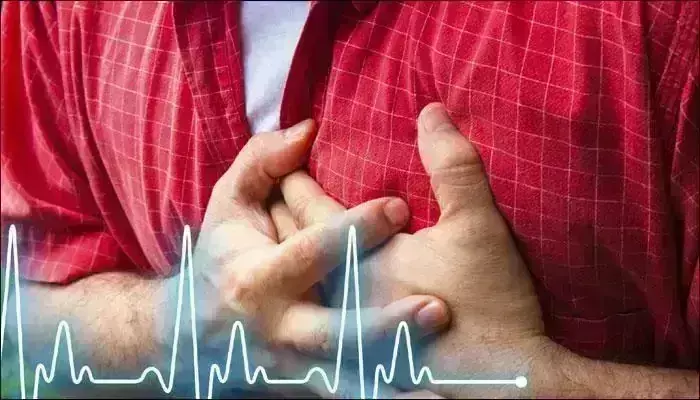- Home
- Medical news & Guidelines
- Anesthesiology
- Cardiology and CTVS
- Critical Care
- Dentistry
- Dermatology
- Diabetes and Endocrinology
- ENT
- Gastroenterology
- Medicine
- Nephrology
- Neurology
- Obstretics-Gynaecology
- Oncology
- Ophthalmology
- Orthopaedics
- Pediatrics-Neonatology
- Psychiatry
- Pulmonology
- Radiology
- Surgery
- Urology
- Laboratory Medicine
- Diet
- Nursing
- Paramedical
- Physiotherapy
- Health news
- Fact Check
- Bone Health Fact Check
- Brain Health Fact Check
- Cancer Related Fact Check
- Child Care Fact Check
- Dental and oral health fact check
- Diabetes and metabolic health fact check
- Diet and Nutrition Fact Check
- Eye and ENT Care Fact Check
- Fitness fact check
- Gut health fact check
- Heart health fact check
- Kidney health fact check
- Medical education fact check
- Men's health fact check
- Respiratory fact check
- Skin and hair care fact check
- Vaccine and Immunization fact check
- Women's health fact check
- AYUSH
- State News
- Andaman and Nicobar Islands
- Andhra Pradesh
- Arunachal Pradesh
- Assam
- Bihar
- Chandigarh
- Chattisgarh
- Dadra and Nagar Haveli
- Daman and Diu
- Delhi
- Goa
- Gujarat
- Haryana
- Himachal Pradesh
- Jammu & Kashmir
- Jharkhand
- Karnataka
- Kerala
- Ladakh
- Lakshadweep
- Madhya Pradesh
- Maharashtra
- Manipur
- Meghalaya
- Mizoram
- Nagaland
- Odisha
- Puducherry
- Punjab
- Rajasthan
- Sikkim
- Tamil Nadu
- Telangana
- Tripura
- Uttar Pradesh
- Uttrakhand
- West Bengal
- Medical Education
- Industry
Reduced Grey-White Matter Ratio on Early Brain CT may predict In-Hospital Mortality after cardiac arrest: Study

Recent study conducted a retrospective cohort analysis on 2,204 post-arrest patients to investigate the performance of the grey matter to white matter radiodensity ratio (GWR) on computed tomography in predicting outcomes following cardiac arrest within the first 24 hours post-arrest. The mean age of the patients was 59 years, with 40% being female. Brain CTs were performed a median of 4.1 hours post-arrest. Of the included patients, 75% died prior to hospital discharge, with 11% progressing to death by neurologic criteria. The cohort had a median GWR of 1.32, with 22% having a GWR <1.20 and 14% having a GWR <1.10.
Primary Outcome Analysis
The primary outcome revealed that GWR sensitivity for predicting in-hospital mortality increased over time, peaking between hours six and twelve at 24% for GWR <1.10 and 34% for GWR <1.20. The false positive rates remained below 5% across all time points. The sensitivity for predicting death by neurologic criteria peaked at hour five, reaching 70% with GWR <1.10 and 84% with GWR <1.20, with higher false positive rates compared to in-hospital mortality predictions.
Sensitivity Analysis
The study also conducted a sensitivity analysis, which confirmed similar trends in sensitivity and false positive rates for both outcomes, with higher absolute values. The analysis revealed that GWR sensitivity for predicting in-hospital mortality peaked at 49% with GWR <1.20, while sensitivity for death by neurologic criteria peaked at 84% with GWR <1.20. False positive rates for both outcomes ranged from 0% to 20% for in-hospital mortality and 0% to 40% for death by neurologic criteria.
Conclusion
The study concluded that reduced GWR on early brain CT is sensitive in predicting in-hospital mortality in approximately 20% of patients when obtained more than four hours post-arrest, with a false positive rate of less than 5%. Sensitivity for predicting death by neurologic criteria was highest between four and five hours post-arrest but accompanied by a high false positive rate. The authors suggested that while early brain CT scans within the first 24 hours post-arrest may help evaluate neurologic etiologies, they may have limitations as independent prognostic markers.
Key Points
- Retrospective cohort analysis on 2,204 post-arrest patients to assess the grey matter to white matter radiodensity ratio (GWR) on CT scans in predicting outcomes within 24 hours post-arrest.
- Primary outcome analysis revealed that GWR sensitivity for predicting in-hospital mortality increased over time, peaking between hours six and twelve, with a sensitivity of 24% for GWR <1.10 and 34% for GWR <1.20.
- Sensitivity for predicting death by neurologic criteria peaked at hour five, reaching 70% with GWR <1.10 and 84% with GWR <1.20, although higher false positive rates were noted compared to in-hospital mortality predictions.
- Sensitivity analysis confirmed similar trends in sensitivity and false positive rates for both outcomes, with higher absolute values, showing GWR sensitivity peaks at 49% for predicting in-hospital mortality with GWR <1.20 and 84% for death by neurologic criteria.
- Reduced GWR on early brain CT scans is sensitive in predicting in-hospital mortality in about 20% of patients when obtained more than four hours post-arrest, with a false positive rate below 5%.
- While early brain CT scans post-arrest may aid in assessing neurologic causes, they may have limitations as stand-alone prognostic markers, as indicated by the study's findings.
Reference –
Nicholas P. Case et al. (2024). Time-Dependent Association Of Grey-White Ratio On Early Brain CT Predicting Outcomes After Cardiac Arrest At Hospital Discharge.. *Resuscitation*, 110440 . https://doi.org/10.1016/j.resuscitation.2024.110440.
MBBS, MD (Anaesthesiology), FNB (Cardiac Anaesthesiology)
Dr Monish Raut is a practicing Cardiac Anesthesiologist. He completed his MBBS at Government Medical College, Nagpur, and pursued his MD in Anesthesiology at BJ Medical College, Pune. Further specializing in Cardiac Anesthesiology, Dr Raut earned his FNB in Cardiac Anesthesiology from Sir Ganga Ram Hospital, Delhi.


